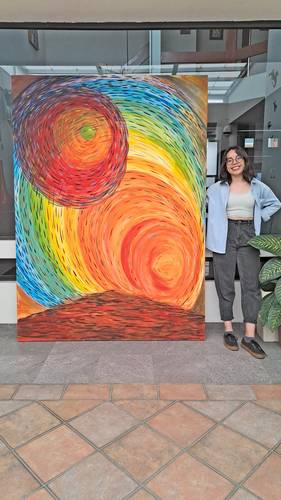The Benemérita Universidad Autónoma de Puebla (BUAP) project on color and music is based on a question asked by Isaac Newton more than three centuries ago, when he discovered that the nature of light was composed of colors: was there a connection between color and music, because they are wave phenomena?
Dr. César Pérez Córdova, professor and researcher at the faculties of Engineering and Arts at BUAP, has managed to translate, using a keyboard, the mathematical frequencies of musical notes into colors that can be used to create pictorial works.
In interview with The Day, Pérez Córdova spoke about this historical milestone and what the steps were like for this transcendental discovery.
“The research began in 2011, from the question that Newton asked himself in the 17th century, when he discovered the nature of light and saw that it was composed of colors; Then, he wondered if there was a relationship between color and music, since both are wave phenomena.
“Although they are different in nature and frequencies, both forms are very similar. Everything has been directed towards what we call ‘synesthesia’, which is the ability to perceive the senses differently.
We are talking about activating the perception of a color when a musical note is heard; However, studies that recognize this phenomenon affirm that each case is different and, therefore, each individual perceives different chromatic tones.
assured the researcher.
Since it is not a uniform phenomenon, since not all people perceive the same colors, our way of investigating it is complicated
.
For example, the Russian composer and pianist Alexander Scriabin, who was a synesthete, created the musical piece Prometheus (also known as The poem of fire). For this symphonic creation, he used a light keyboard (light keyboard, in Spanish), which worked as a sequencer, and on the score he noted the color that each note represented. However, the composer assured that it was not a mapping, as it was only based on what he saw.
Recently, at Yale University there was a presentation of this poem by Scriabin. But in our case, for the first time a project is going to be released that talks about the relationship between color and music through mathematical, physical and acoustic foundations using a computer program.
explained Pérez Córdova.
▲The piece light ropes form part of the project promoted by the BUAP on color and music.Photo courtesy of César Pérez Córdova
Something similar happened with the works of Vasili Kandinsky, who even stated that listening to tones and chords while painting, he detected that yellow It is the color of the center in a brass trumpet, and black, the color of the closure and the end of things
. The artist claimed that color combinations produce vibratory frequencies, similar to chords played on a piano. With this he developed a theory of geometric figures and their relationships.
He even stated that The circle is the most peaceful shape, which represents the human soul
and that like colors, shapes will have their spiritual effects: triangles are more related to warm tones (yellow, red); this, due to the acuity of its angles; In the case of deep colors, they are related to more square and round shapes
.
Pérez Córdova stated that in his case, The first thing I did was create a musical scale using mathematics; We multiplied the sequences and managed to mark the entire musical scale, then I converted them to the RGB color code (acronym for red, blue and green, for its acronym in English) and mixed the sounds
.
The researcher then made a program to represent music in colors after reversing what he learned through the musical scale.
Later, students from the BUAP Faculty of Arts joined together, and with them we achieved a project in which music and painting can be done simultaneously; This is what we are going to present soon.
The scientist is happy and at the same time surprised, because We manage to develop music and painting based on mathematical foundations, which allows us to make the public experience what a synesthetic person can perceive. We managed to improve and perfect the Scriabin color keyboard
.
For Pérez Córdova, this discovery is something that could help deepen knowledge about how our brain perceives the senses, beyond artistic uses.
The results of this work will be presented on May 8 at noon in the theater of the BUAP university cultural complex; Dr. César Pérez and members of the Faculty of Arts of that school will participate, who will simultaneously create pictorial and musical works, in addition to explaining the operation of this new theory that will allow the paths of color and music to be united.
